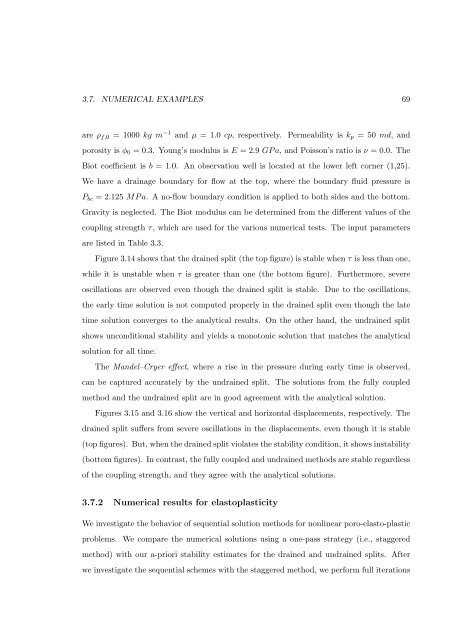Sequential Methods for Coupled Geomechanics and Multiphase Flow
Sequential Methods for Coupled Geomechanics and Multiphase Flow
Sequential Methods for Coupled Geomechanics and Multiphase Flow
Create successful ePaper yourself
Turn your PDF publications into a flip-book with our unique Google optimized e-Paper software.
3.7. NUMERICAL EXAMPLES 69<br />
are ρf,0 = 1000 kg m −1 <strong>and</strong> µ = 1.0 cp, respectively. Permeability is kp = 50 md, <strong>and</strong><br />
porosity is φ0 = 0.3. Young’s modulus is E = 2.9 GPa, <strong>and</strong> Poisson’s ratio is ν = 0.0. The<br />
Biot coefficient is b = 1.0. An observation well is located at the lower left corner (1,25).<br />
We have a drainage boundary <strong>for</strong> flow at the top, where the boundary fluid pressure is<br />
Pbc = 2.125 MPa. A no-flow boundary condition is applied to both sides <strong>and</strong> the bottom.<br />
Gravity is neglected. The Biot modulus can be determined from the different values of the<br />
coupling strength τ, which are used <strong>for</strong> the various numerical tests. The input parameters<br />
are listed in Table 3.3.<br />
Figure 3.14 shows that the drained split (the top figure) is stable when τ is less than one,<br />
while it is unstable when τ is greater than one (the bottom figure). Furthermore, severe<br />
oscillations are observed even though the drained split is stable. Due to the oscillations,<br />
the early time solution is not computed properly in the drained split even though the late<br />
time solution converges to the analytical results. On the other h<strong>and</strong>, the undrained split<br />
shows unconditional stability <strong>and</strong> yields a monotonic solution that matches the analytical<br />
solution <strong>for</strong> all time.<br />
The M<strong>and</strong>el–Cryer effect, where a rise in the pressure during early time is observed,<br />
can be captured accurately by the undrained split. The solutions from the fully coupled<br />
method <strong>and</strong> the undrained split are in good agreement with the analytical solution.<br />
Figures 3.15 <strong>and</strong> 3.16 show the vertical <strong>and</strong> horizontal displacements, respectively. The<br />
drained split suffers from severe oscillations in the displacements, even though it is stable<br />
(top figures). But, when the drained split violates the stability condition, it shows instability<br />
(bottom figures). In contrast, the fully coupled <strong>and</strong> undrained methods are stable regardless<br />
of the coupling strength, <strong>and</strong> they agree with the analytical solutions.<br />
3.7.2 Numerical results <strong>for</strong> elastoplasticity<br />
We investigate the behavior of sequential solution methods <strong>for</strong> nonlinear poro-elasto-plastic<br />
problems. We compare the numerical solutions using a one-pass strategy (i.e., staggered<br />
method) with our a-priori stability estimates <strong>for</strong> the drained <strong>and</strong> undrained splits. After<br />
we investigate the sequential schemes with the staggered method, we per<strong>for</strong>m full iterations
















